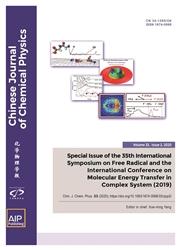15 N/14N isotopic exchange in the dissociative adsorption of N2 on tantalum nitride cluster anions Ta3N3−
IF 1.2
4区 化学
Q4 PHYSICS, ATOMIC, MOLECULAR & CHEMICAL
引用次数: 2
Abstract
Adsorption and activation of dinitrogen (N2) is an indispensable process in nitrogen fixation. Metal nitride species continue to attract attention as a promising catalyst for ammonia synthesis. However, the detailed mechanisms at a molecular level between reactive nitride species and N2 remain unclear at elevated temperature, which is important to understand the temperature effect and narrow the gap between the gas phase system and condensed phase system. Herein, the 14N/15N isotopic exchange in the reaction between tantalum nitride cluster anions Ta314N3− and 15N2 leading to the regeneration of 14N2/14N15N was observed at elevated temperature (393−593 K) using mass spectrometry. With the aid of theoretical calculations, the exchange mechanism and the effect of temperature to promote the dissociation of N2 on Ta3N3− were elucidated. A comparison experiment for Ta314N4−/15N2 couple indicated that only desorption of 15N2 from Ta314N415N2− took place at elevated temperature. The different exchange behavior can be well understood by the fact that nitrogen vacancy is a requisite for the dinitrogen activation over metal nitride species. This study may shed light on understanding the role of nitrogen vacancy in nitride species for ammonia synthesis and provide clues in designing effective catalysts for nitrogen fixation.氮化钽簇阴离子Ta3N3−上15n /14N的同位素交换
二氮的吸附和活化是固氮过程中不可缺少的一个环节。金属氮化物作为一种很有前途的氨合成催化剂不断受到人们的关注。然而,在高温下,活性氮化物与N2在分子水平上的详细机制尚不清楚,这对于理解温度效应和缩小气相体系与凝聚相体系之间的差距具有重要意义。在高温(393 ~ 593 K)条件下,利用质谱法观察了氮化钽簇阴离子Ta314N3 -和15N2之间的14N/15N同位素交换导致14N2/14N15N的再生。通过理论计算,阐明了温度对Ta3N3−上N2解离的影响及交换机理。Ta314N4−/15N2对的对比实验表明,在高温下Ta314N415N2−只发生15N2的解吸。氮空位是金属氮化物上二氮活化的必要条件,这一事实可以很好地理解不同的交换行为。该研究有助于理解氮化物中氮空位在氨合成中的作用,并为设计有效的固氮催化剂提供线索。
本文章由计算机程序翻译,如有差异,请以英文原文为准。
求助全文
约1分钟内获得全文
求助全文
来源期刊

Chinese Journal of Chemical Physics
物理-物理:原子、分子和化学物理
CiteScore
1.90
自引率
10.00%
发文量
2763
审稿时长
3 months
期刊介绍:
Chinese Journal of Chemical Physics (CJCP) aims to bridge atomic and molecular level research in broad scope for disciplines in chemistry, physics, material science and life sciences, including the following:
Theoretical Methods, Algorithms, Statistical and Quantum Chemistry
Gas Phase Dynamics and Structure: Spectroscopy, Molecular Interactions, Scattering, Photochemistry
Condensed Phase Dynamics, Structure, and Thermodynamics: Spectroscopy, Reactions, and Relaxation Processes
Surfaces, Interfaces, Single Molecules, Materials and Nanosciences
Polymers, Biopolymers, and Complex Systems
Other related topics
 求助内容:
求助内容: 应助结果提醒方式:
应助结果提醒方式:


